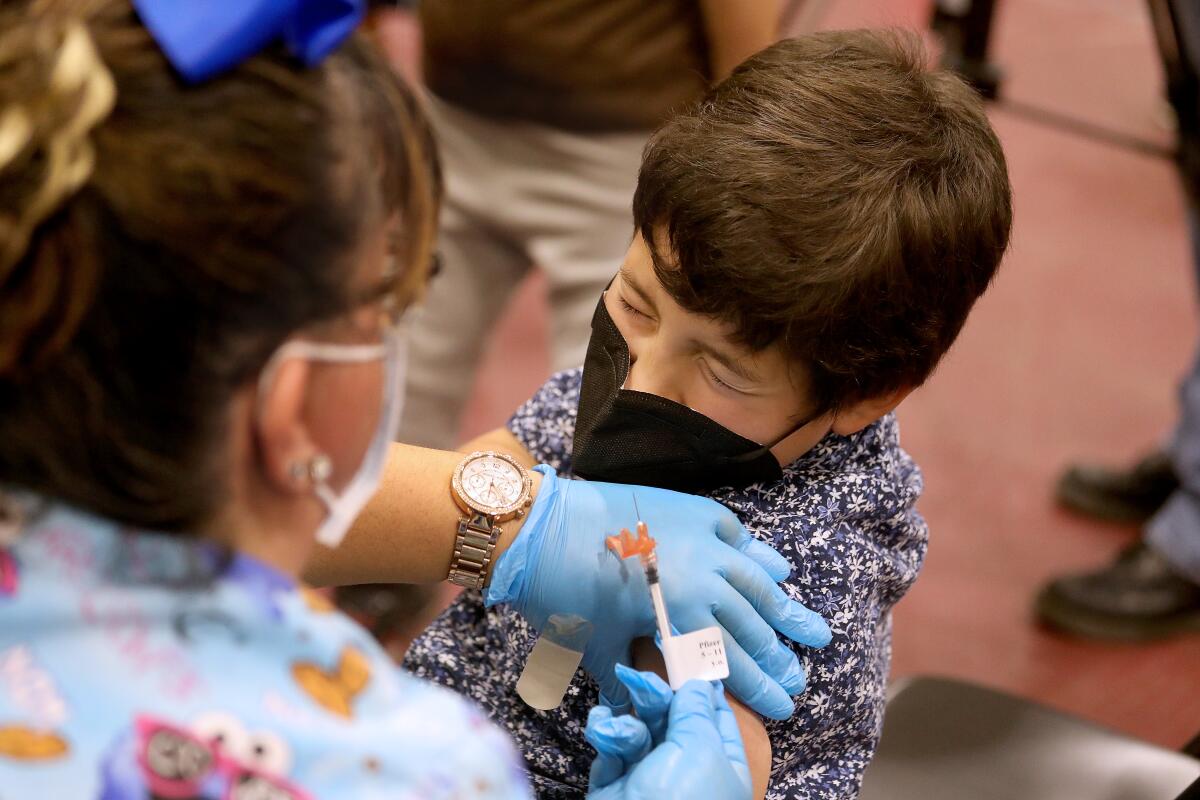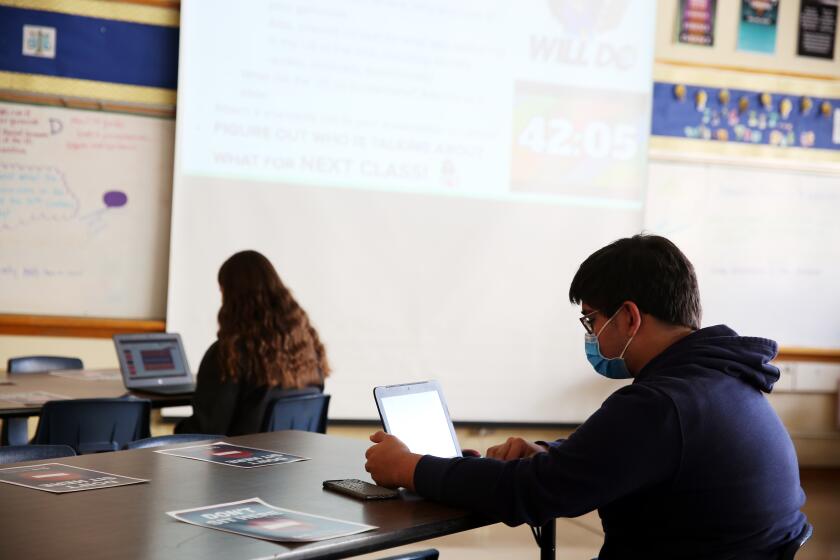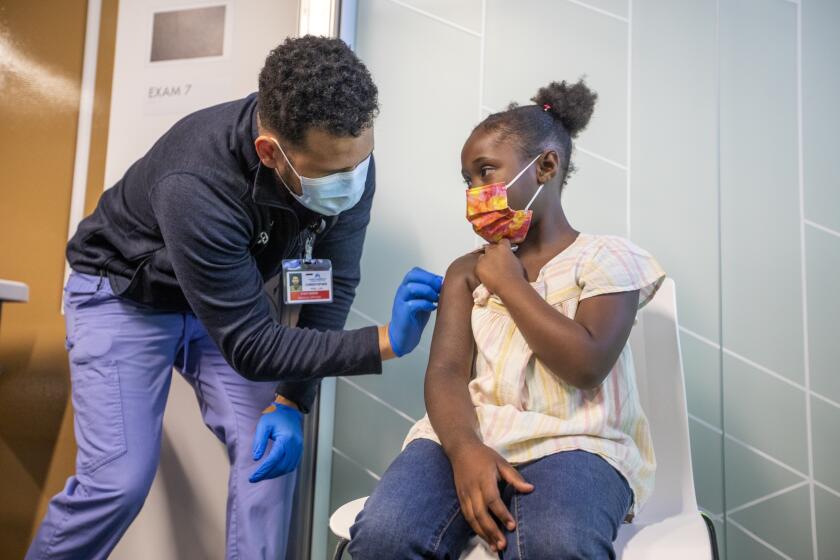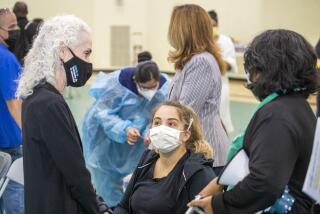COVID-19 isn’t like chickenpox. How to get school vaccination mandates right

- Share via
Almost all children 5 or older (as well as those reluctant adults) should receive their COVID-19 vaccinations, especially now that we’re learning some frightening information about how quickly and easily the Omicron variant spreads. But a judge’s tentative ruling last week scrapping the vaccine mandate imposed by San Diego schools shows that getting there via school district policies is far more complicated than it seems.
The San Diego Unified School District would have required full vaccination only of students 16 and older for now, with exemptions for medical reasons. Meanwhile, Los Angeles Unified has already backed down from its more stringent vaccine mandate for students 12 and older because so many families appeared to be flouting the rule, which was scheduled to take effect after winter break.
In his ruling against San Diego County, Superior Court Judge John S. Meyer made it clear he isn’t happy about parents who resist vaccinating their kids. He called the district’s vaccine mandate “necessary and rational” and made no finding that parents have an inherent individual right to defy rules that protect public health. Rather, his decision was based on legal issues of local versus state authority.
Newsom’s proposal for COVID-19 vaccines probably won’t go into effect until July 2022 and doesn’t cover teachers. It’s not even close to what schools need from the state.
State law lists which vaccinations are required to attend school, with no personal exemption, but that law was drawn up years before there was such a thing as COVID-19. Only students with a legitimate medical issue can attend school — private or public — unvaccinated for measles, mumps, diphtheria and seven other diseases, almost all of them contagious.
State intervention is needed, in a stronger form than Gov. Gavin Newsom has offered so far, but also planned in a nuanced way. Parents’ resistance to COVID-19 vaccination flies in the face of science, but at the same time, inoculating people against this virus isn’t the same as administering the measles vaccine or other standard childhood immunizations.
The most bulletproof way to go would be new legislation adding the COVID-19 vaccine to the list of required childhood immunizations, but that’s not necessarily the most effective way to go about it. COVID-19 isn’t like chickenpox, for which inoculation plus a booster is enough for all of childhood. We don’t know how the coronavirus will change, or if a vaccine shot will be needed every year.
Prepare for big spikes in COVID-19 hospitalizations and deaths in areas with low vaccination rates, experts say.
The protection offered by the current COVID-19 vaccines appears to fade within several months, and the virus mutates readily. So far, studies indicate that existing vaccines fend off the worst effects of the two major variants, Delta and Omicron. But Omicron might be so contagious that even if the rate of serious cases is low, the effect on hospitals and on public health could be dire because of the sheer number of infected people.
Given the spread of Omicron, mandating the initial doses of existing vaccines, while helpful, might not be enough. Would legislation also require a booster several months later? What about additional boosters that might be called for in the future against new variants?
In October, Newsom announced a vaccine mandate for students in grades 7 through 12 that would take effect starting in the school term after full FDA approval of a vaccine for children ages 12 and older. This means that unless the FDA gives final approval for use of the vaccine in 12- to 15-year-olds by the end of next week (the vaccine is already approved to those 16 and older), Newsom’s rule wouldn’t take effect until next summer. That’s not good enough. Though it’s wise to wait for final approval for each age group, mandates should go into effect within weeks of that happening, not a full semester later.
Even then, Newsom’s plan leaves a hole wide enough for a whole convoy of vaccine resisters to drive through by allowing the personal belief exemption. That’s because state law requires that any vaccination requirement issued by state health officials, without a vote of the Legislature, must allow parents to opt out for religious or idealogical reasons.
The most practical way to impose vaccine mandates on schools is for lawmakers to pass emergency legislation that empowers the Department of Public Health to make the required rules and change them as the situation evolves — including eliminating the personal belief exemption — but limit that authority to a year or two.
That would give Newsom the legal backup to move quickly and aggressively on the school vaccination front.
But he should not hold off until then. He should introduce a quicker, more stringent vaccine mandate as soon as FDA approval arrives for each age group, with no personal exemptions.
Omicron isn’t waiting for legislative committee hearings and neither should the state.
More to Read
A cure for the common opinion
Get thought-provoking perspectives with our weekly newsletter.
You may occasionally receive promotional content from the Los Angeles Times.











